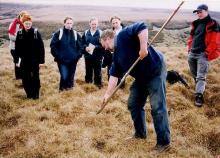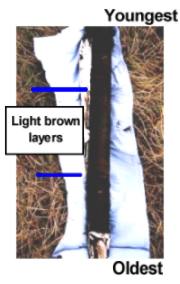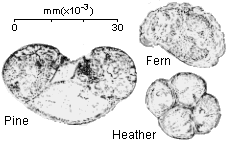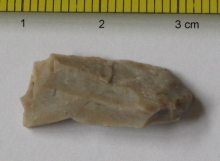Hidden History

- The slow rate of decomposition means that peat stores an excellent record of the plants which grew in the bog over thousands of years.
- Peat in the Dark Peak preserves a record of changing vegetation and climate over the last 5,000 years.
- It also preserves other sorts of organic material - for example the famous Iron Age bog bodies such as Lindow Man, found in nearby Cheshire.
- We can use the record of changing flora and fauna from peat bogs in Britain to find out how climate has changed and how people have altered the landscape since the end of the last Ice Age, about ten thousand years ago.
- A Russian corer can be used to extract a 2m peat core in 50cm sections.
- The core can then be analysed to reconstruct paleoenvironments:.
1. Stratigraphy

- Lighter brown layers (in the middle of the core shown here) are less well humified, indicating a rapid rate of peat accumulation & wetter conditions.
- Charcoal layers (black, burnt horizons) indicate fire; either accidental or deliberate.
- Youngest peat is at the top of the core (nearer the peat's surface), oldest peat is at the bottom of the core (towards the underlying mineral soil).
- Why are there different coloured layers in a peat core? - Relates to the rate of peat accumulation & humification.
2. Palynology

- Pollen grains are preserved in peat.
- Their distinctive shapes and surface textures allow us to identify the plant from which it came.
- The picture shows pine, heather and fern pollen - you can see how different each one is, allowing each species to be identified.
- Counting the number of pollen grains of each species allows us to reconstruct a picture of past vegetation
- Samples taken from different depths in the core produce a pollen diagram showing how the vegetation changed over time due to climatic change or human activity or disease.
- The pollen diagram can be dated using radiocarbon or other dating techniques.
3. Paleomagnetics
- Tiny particles of heavy metals, such as magnetite, are deposited from the air onto the peat surface.
- As peat accumulates, this preserves a record of past air pollutants - recording the amount and types of particles found in the atmosphere in the past.
- Study of the magnetic properties of the peat reveals the history of air pollution.
4. Archaeological Artifacts

- Small flints (microliths) used by Mesolithic people have been found at the base of the peat.
- They were mounted in a bone handle - rather like the teeth of a comb - and used to scrape animal skins clean.
- They are a further indication of human activity in the Dark Peak - thus showing they had a role to play in peat formation.
Next... Peat erosion.